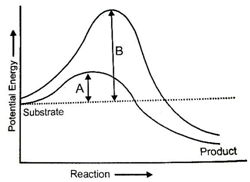Which of the following is true?
1.Inorganic catalyst work efficiently at high temperatures and high pressures
2.Generally, enzymes get damaged at high temperatures
3.Thermostable enzymes retain their catalytic power even at high temperatures.
4.All of these
Which of the following is correct?
1.Physical change refers to change in shape without breaking the bonds
2.Change in state of matter also takes place in physical change
3.Chemical change involves breaking of old bonds and formation of new ones.
4.All of these
Which of the following is true?
1.Rate of physical or chemical process refers to the amount of product formed per unit time.
2.Rate can also be called as velocity of the reaction
3.Rate of reaction is influenced by temperature.
4.All of these
Enzymes work at optimum temperature. Over a range of 0 to 400C, what would happen to the rate of enzyme controlled reactions for every 100C rise in temperature?
1.The rate doubles itself
2.Decreases by half
3.No effect
4.First increases then decreases
Which of the following is true about carbonic anhydrase?
1.It accelerates the rate of formation of carbonic acid by 10 million times.
2.In its absence only 200 molecules of carbonic acid is formed in an hour.
3.It forms 600,000 molecules of carbonic acid in one second.
4.All of these
Find the correct statement
1.Catalysed reactions proceed at rates higher than that of uncatalysed ones.
2.In skeletal muscle under anaerobic conditions lactic acid is formed from pyruvic acid.
3.In yeast during fermentation ethanol is formed from pyruvic acid.
4.All of these
Which of the following is correct?
1.The chemical or metabolic conversion refers to a reaction.
2.The chemical which is converted into a product is called a substrate.
3.Proteins with three dimensional structures including an active site is called enzyme.
4.All of these
Which of the following describes the given graph correctly?

1.Endothermic reaction with energy A in presence of enzyme and B in absence of enzyme
2.Exothermic reaction with energy A in presence of enzyme and B in absence of enzyme
3.Endothermic reaction with energy A in absence of enzyme and B in presence of enzyme
4.Exothermic reaction with energy A in absence of enzyme and B in presence of enzyme
The figure given below shows the conversion of a substrate into product by an enzyme. In which one of the four options (1 - 4) the components of reaction labelled as A, B, C and D are identified correctly ?
|
A |
B |
C |
D |
|
|
1. |
Potential energy |
Transition state |
Activation Energy with enzyme |
Activation energy with- out enzyme |
|
2. |
Transition State |
Potential Energy |
Activation Energy with-out enzyme |
Activation energy with enzyme |
|
3. |
Activation energy with-out enzyme |
Transition state |
Activation energy with enzyme |
Potential energy |
|
4. |
Activation energy with enzyme |
Transition state |
Activation energy with-out enzyme |
Potential energy |
Which of the following is correct?
1.The ES complex formation is a transient phenomenon
2.The structure of the substrate gets transformed into the structure of product.
3.All the structures formed between substrate and product are called intermediates.
4.All of these







